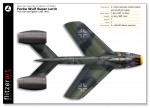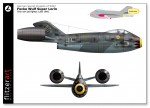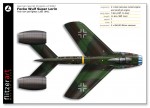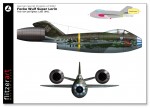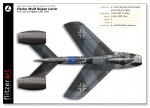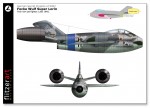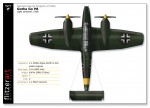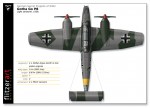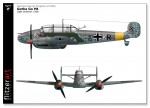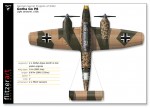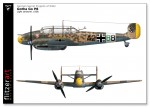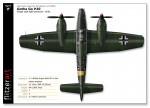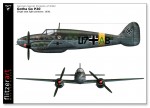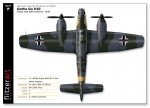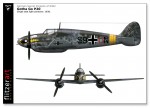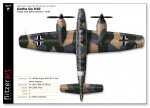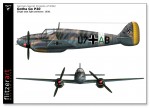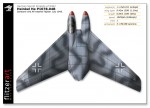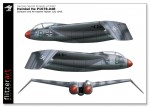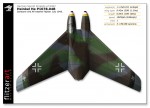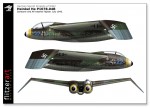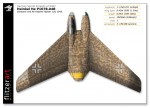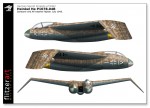German Secret Projects Volume 7
1
Comment
Focke-Wulf Super Lorin Ramjet Fighter
Around the same time as Focke-Wulf produced the Ta283 Ramjet design they also produced this alternative ‘Super Lorin’ concept.
Like the Ta283 it also used two Pabst ramjets mounted at one at each end of the swept tail stabilisers and incorporated a tail mounted rocket motor. The ‘Super Lorin’ design however also housed a small turbojet within the fuselage drawing air through the intake in the nose but exhausting thrust downwards and backwards at an angle under the rear fuselage (Please see profile for diagram).
Both the rocket motor and turbojet would have been used for take-ff and initial acceleration to bring the aircraft up to the ramjet operating speed of around 300mph.
Gotha P8 and P20 Light Zerstorers
As early as 1938 the Gothaer Waggonfabrik submitted 3 designs by Dipl-Ing Egwin Leiber for a ‘light zerstorer’. The reasoning behind these ‘light’ zerstorers was that they would, in theory, have been more than adequate for home and regional defence against, what was then, the opposition’s inferior aircraft. The RLM rejected all of them.
However much later in the war, this idea was explored further in the form of the ‘Nahkampfflugzeuge’ (close combat aircraft). i.e. swarms of small, light aircraft getting in amongst enemy bomber formations.
Profile Notes: The P8 and P20 were two of the 3 designs originally submitted. Little exact data is available and the profiles here are based on the 3-veiw drawings that did survive the war. The P8 was for a 2-man crew and the P20 a single-seater.
Heinkel P1078B Twin-nose Fighter
It is commonly believed Heinkel produced three designs bearing the project number P1078, namely A, B and C although it is unconfirmed that design A was indeed part of the P1078 programme.
Concerning design B, illustrated here, Seigfied Gunter, found that after initial planning to design an all-wing fighter design with as small as possible fuselage to wing ratio, it would be deemed to be unstable. Hoping to restore stability he produced a very unusual new design with a very unusual solution of basically a flying wing with twin extended fuselage pods framing the jet intake in between. I am reminded of a catamaran in some ways. The port pod housed the cockpit while the starboard pod carried the front undercarriage and armament. The wing tips angled downwards (cathedral). Together these features resulted in increased stability and an extremely ‘flat’ profile. The wing would have comprised three main separately built sections, allowing for easier assembly, the ‘cathedral’ wing tips being detachable.
Around the same time as Focke-Wulf produced the Ta283 Ramjet design they also produced this alternative ‘Super Lorin’ concept.
Like the Ta283 it also used two Pabst ramjets mounted at one at each end of the swept tail stabilisers and incorporated a tail mounted rocket motor. The ‘Super Lorin’ design however also housed a small turbojet within the fuselage drawing air through the intake in the nose but exhausting thrust downwards and backwards at an angle under the rear fuselage (Please see profile for diagram).
Both the rocket motor and turbojet would have been used for take-ff and initial acceleration to bring the aircraft up to the ramjet operating speed of around 300mph.
Gotha P8 and P20 Light Zerstorers
As early as 1938 the Gothaer Waggonfabrik submitted 3 designs by Dipl-Ing Egwin Leiber for a ‘light zerstorer’. The reasoning behind these ‘light’ zerstorers was that they would, in theory, have been more than adequate for home and regional defence against, what was then, the opposition’s inferior aircraft. The RLM rejected all of them.
However much later in the war, this idea was explored further in the form of the ‘Nahkampfflugzeuge’ (close combat aircraft). i.e. swarms of small, light aircraft getting in amongst enemy bomber formations.
Profile Notes: The P8 and P20 were two of the 3 designs originally submitted. Little exact data is available and the profiles here are based on the 3-veiw drawings that did survive the war. The P8 was for a 2-man crew and the P20 a single-seater.
Heinkel P1078B Twin-nose Fighter
It is commonly believed Heinkel produced three designs bearing the project number P1078, namely A, B and C although it is unconfirmed that design A was indeed part of the P1078 programme.
Concerning design B, illustrated here, Seigfied Gunter, found that after initial planning to design an all-wing fighter design with as small as possible fuselage to wing ratio, it would be deemed to be unstable. Hoping to restore stability he produced a very unusual new design with a very unusual solution of basically a flying wing with twin extended fuselage pods framing the jet intake in between. I am reminded of a catamaran in some ways. The port pod housed the cockpit while the starboard pod carried the front undercarriage and armament. The wing tips angled downwards (cathedral). Together these features resulted in increased stability and an extremely ‘flat’ profile. The wing would have comprised three main separately built sections, allowing for easier assembly, the ‘cathedral’ wing tips being detachable.
Comments
Many thanks Rowan
for doing a great job again in getting it up and running.
Cheers
Peter
NOV 26, 2010 - 10:59 PM
Copyright ©2021 by Peter Allen. Images also by copyright holder unless otherwise noted. The views and opinions expressed herein are solely the views and opinions of the authors and/or contributors to this Web site and do not necessarily represent the views and/or opinions of AeroScale, KitMaker Network, or Silver Star Enterrpises. Images also by copyright holder unless otherwise noted. Opinions expressed are those of the author(s) and not necessarily those of AeroScale. All rights reserved. Originally published on: 2010-11-22 00:00:00. Unique Reads: 19066




